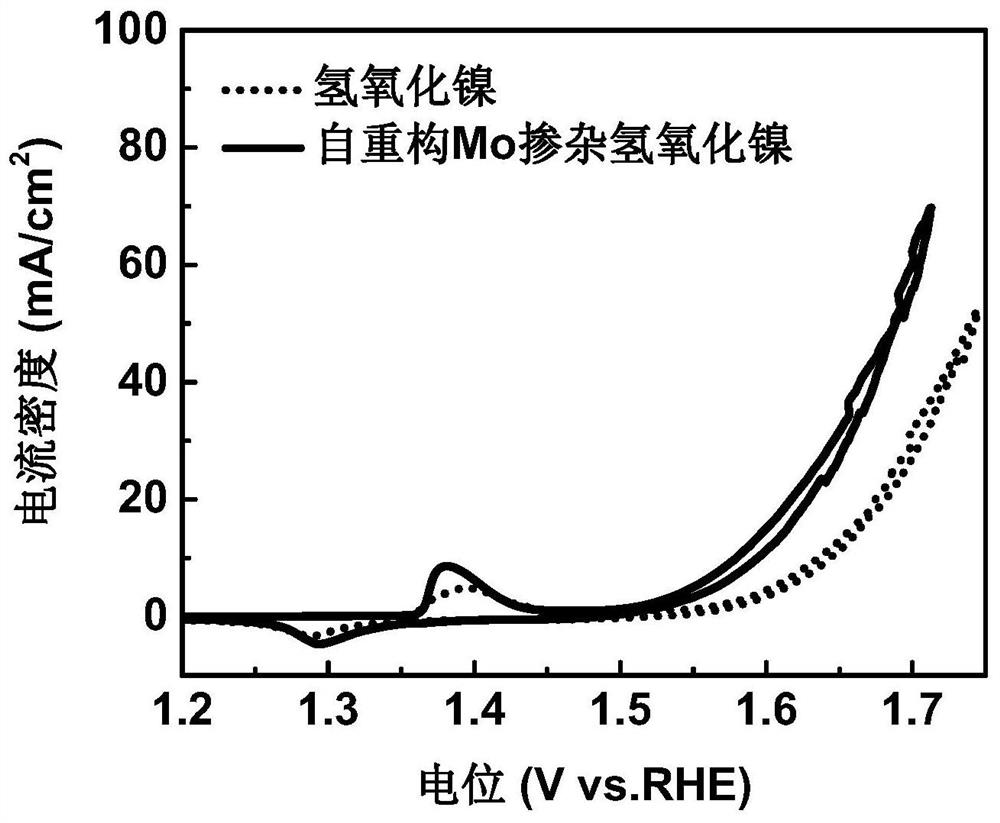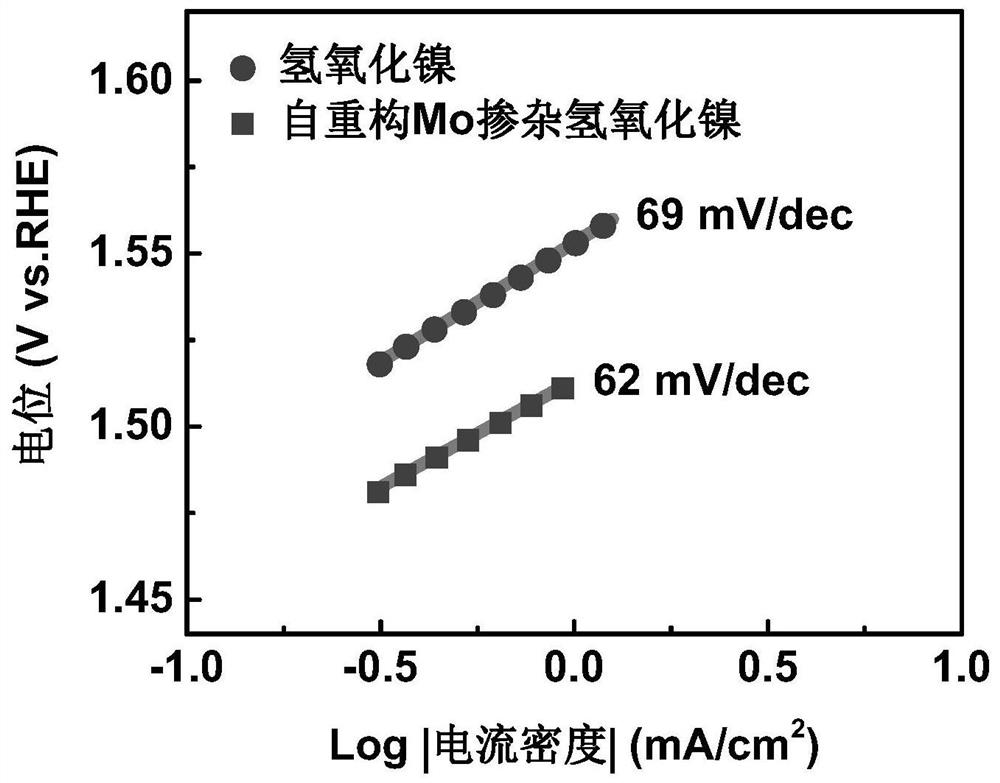Mo-doped transition metal hydroxide electrocatalyst constructed through deep self-reconstruction as well as preparation method and application of Mo-doped transition metal hydroxide electrocatalyst
A technology of hydroxide electricity and transition metals, applied in the direction of electrodes, electrolysis processes, electrolysis components, etc., can solve the problems of insufficient utilization of the internal components of the catalyst, limited depth, etc., and achieve low raw material prices, low production costs, and applicable wide-ranging effect
- Summary
- Abstract
- Description
- Claims
- Application Information
AI Technical Summary
Problems solved by technology
Method used
Image
Examples
Embodiment 1
[0060] (1) Molybdenum disulfide nanosheet arrays were prepared by hydrothermal synthesis on a carbon cloth substrate;
[0061] (2) Wash the molybdenum disulfide nanosheet array grown on the carbon cloth obtained in step (1) several times with pure water, and dry it in vacuum at 50° C. for 5 hours to obtain the dried molybdenum disulfide nanosheet array;
[0062] (3) activating the dried molybdenum disulfide nanosheet array obtained in step (2) at -0.6V (vs.RHE) overpotential for 300s to obtain activated molybdenum disulfide nanosheets;
[0063] (4) Soak molybdenum disulfide nanosheets after the activation of step (3) gained concentration in the nickel acetate solution of 30mM, the time of immersion is 5min, with molybdenum disulfide nanosheets as template 2+ Carry out adsorption to obtain molybdenum disulfide / hydroxide composite material;
[0064] (5) Soak the molybdenum disulfide / hydroxide composite material obtained in step (4) in KOH solution (concentration is 0.1M), then ...
Embodiment 2
[0068] (1) Molybdenum disulfide nanosheet arrays were prepared by hydrothermal synthesis on a carbon cloth substrate;
[0069] (2) The molybdenum disulfide nanosheet array grown on the carbon cloth obtained in step (1) is washed several times with pure water, and dried in vacuum at 60° C. for 3 hours to obtain the dried molybdenum disulfide nanosheet array;
[0070] (3) activating the dried molybdenum disulfide nanosheet array obtained in step (2) at -0.6V (vs.RHE) overpotential for 100s to obtain activated molybdenum disulfide nanosheets;
[0071] (4) Soak molybdenum disulfide nanosheets after the activation of the gained step (3) in a ferrous sulfate solution with a concentration of 50mM for 10min, and use molybdenum disulfide nanosheets as a template for Fe 2+ Carry out adsorption to obtain molybdenum disulfide / hydroxide composite material;
[0072] (5) Soak the molybdenum disulfide / hydroxide composite material obtained in step (4) in KOH solution (concentration is 0.5M), ...
Embodiment 3
[0076] (1) Molybdenum disulfide nanosheet arrays were prepared by hydrothermal synthesis on a carbon cloth substrate;
[0077] (2) Wash the molybdenum disulfide nanosheet array grown on the carbon cloth obtained in step (1) several times with pure water, and dry it in vacuum at 60° C. for 5 hours to obtain the dried molybdenum disulfide nanosheet array;
[0078] (3) activating the dried molybdenum disulfide nanosheet array obtained in step (2) at -0.6V (vs.RHE) overpotential for 500s to obtain activated molybdenum disulfide nanosheets;
[0079] (4) Soak molybdenum disulfide nanosheets after the activation of the gained step (3) in the mixed solution of nickel acetate solution and ferrous sulfate solution (according to the volume ratio of 3:1 by the nickel acetate solution of 50mM and the ferrous sulfate solution of 50mM prepared), the soaking time was 20min, and the Ni 2+ and Fe 2+ Adsorption is carried out to obtain molybdenum disulfide / hydroxide composite material.
[008...
PUM
 Login to View More
Login to View More Abstract
Description
Claims
Application Information
 Login to View More
Login to View More - R&D
- Intellectual Property
- Life Sciences
- Materials
- Tech Scout
- Unparalleled Data Quality
- Higher Quality Content
- 60% Fewer Hallucinations
Browse by: Latest US Patents, China's latest patents, Technical Efficacy Thesaurus, Application Domain, Technology Topic, Popular Technical Reports.
© 2025 PatSnap. All rights reserved.Legal|Privacy policy|Modern Slavery Act Transparency Statement|Sitemap|About US| Contact US: help@patsnap.com



